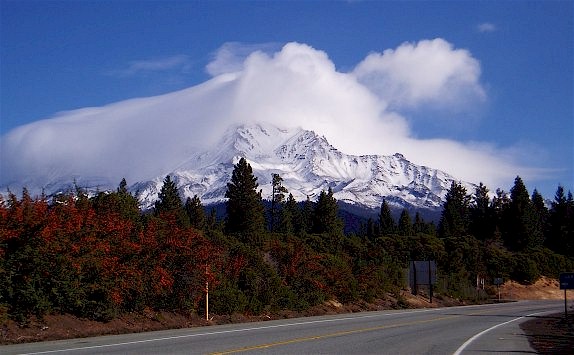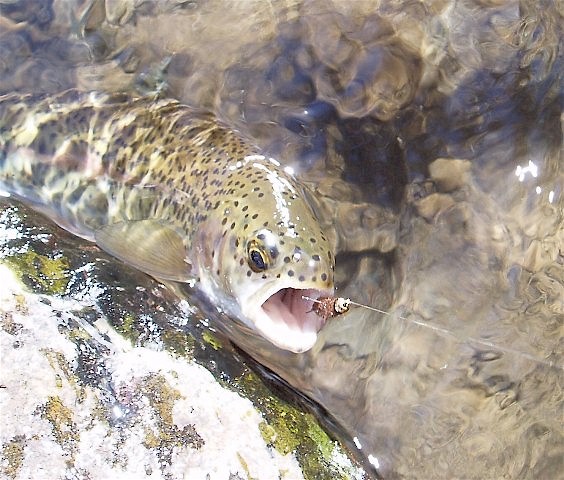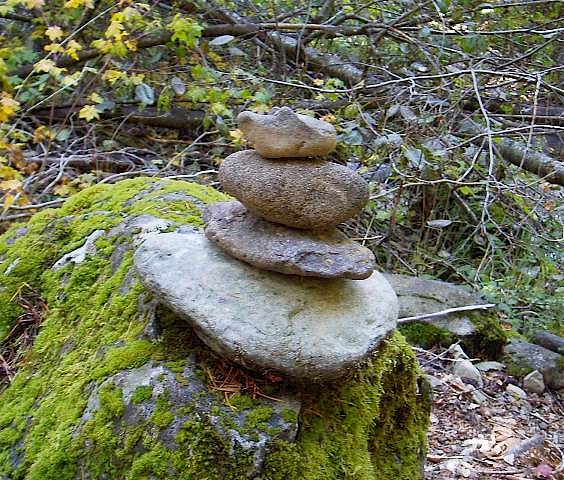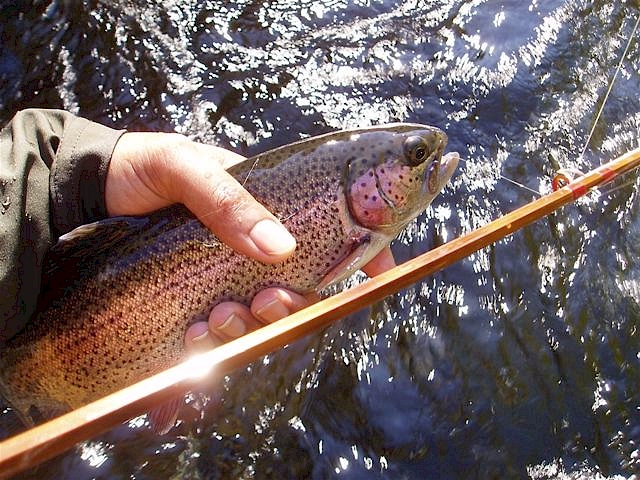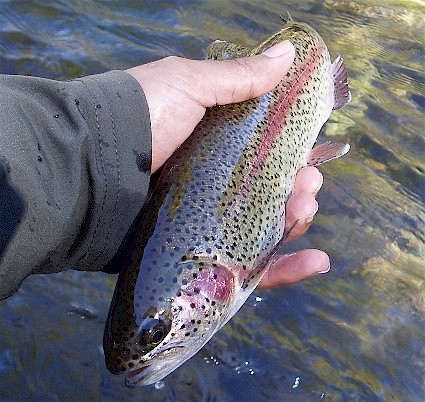|
|
|
|
|
October 6 & 7th, 2007 Upper Sac Time: Saturday 11:30am - 4:30pm , 6:00 -
7:00pm , Sunday 10:00 am - 11:00 am, 11:45am- 1:00pm Narrative:
I'm back! The doctor's cleared me to fish and Mt. Shasta looms ahead as I continue what has been a tradition since the year I first learned to fly fish- the fall Upper Sac trip. It is of course over now. I write this and yearn for more. Vita joined me on this excursion and I had to balance time with She Who Must Be Obeyed and fishing. That means I got all of five hours of fishing Saturday and two hours on Sunday. Not nearly enough. The Gypsy Kings are playing as we blast up I5 to Dunsmuir. The Gypsy Kings are traditional Jim and Mike fishing music and as we round the corner of the Castella Loop, I swing into Castle Crags Campground for old times sake. Mike hasn't made one of these trips in close to 10 years but very little around Dunsmuir changes. Vita is the non-camping sort so she, the dog and I stay at Cave Springs Resort. Cave Springs is an interesting place with cabins, a motel and trailers for accommodations. Yes, trailers, as in trailer park trailers. Vita's most vivid memory of Dunsmuir is the time we were placed in the "deluxe accommodations", a trailer instead of the motel. She hated it. I've made sure to specify "motel" ever since. Queen's never been to Cave Springs and almost immediately she's barking up a storm. The walls are thin and doors open to the parking lot. Cave Springs gets a lot of late arrivals and there are plenty of people milling about late into the evening to keep her on guard for most of the night. We get her to stop barking for the most part but her growling and occasional lapse keep us up most of the night. So it's sleep a little, "Queen, No!, sleep some more, "Queen, Quiet!" until day break.
It's a long night but Saturday comes as it must do. Mt. Shasta dwarfs the surrounding country side as I head down the "Fisherman's Highway", highway 89- destination, Ash Camp on the McCloud River. I'm on the trail by 11:00am and making my way down some random side trail 15 minutes later. I'm not far from the parking lot but there isn't a soul in sight. The McCloud is a rugged combination of deep, long pools and pockets, dense forest, slippery river rock, steep canyon walls and high eroded banks. Most folks fishing this section of river do so within view of the bridge which connects the parking lot to the stream trail. The trail follows the stream but at times does not allow easy access to the stream. Away from the parking lot area, bushwhacking is the order of the day. It is the quintessential fly fishing river, better suited for long drifts of yarn and dry fly fishing than high stick nymphing. I tied on a cased caddis imitation and Sawyer Pheasant Tail Nymph and went to work. The first nymph imitates an October Caddis which become active this time of year and the PT nymph can imitate both the Blue Winged Olive and Pale Morning Dun mayflies I found fluttering about. It didn't take too much time before I landed my first fish, a nice 12 or 13 inches rainbow. In all the years I've fished with an October Caddis imitation, I've never caught fish consistently with one until this year. I was sold on this fly when my line stopped mid drift and I set the hook into my largest fish all year. The cased October Caddis imitation was planted dead center in the upper jaw of what was at least an 18 inch fish. I don't know for sure because the fish flopped onto the end of my leader and swam away before I could photo, measure it or retrieve my fly. I really should carry a net.
Around 2:30 I started seeing increased insect activity. The occasional October Caddis and PMD had been buzzing about but mid afternoon it was obvious that a hatch was on and not just one. There were PMDs, Beatis, a smaller lighter colored mayfly and a medium sized caddis. A half hour later my fish count took a nose dive, it was time to change tactics but to what? Hoping that PMDs and Baetis were on the menu, I changed to a light colored Klinkhammer Special and floating BWO nymph. I noticed a good fish taking dries in a shaded pool. It took several casts before I figured out the currents. I'm not much of a dry fly fisherman but I do feel as if I'm finally starting to get the hang of Joe Humpreys' slack line cast, which throws coils into the leader as opposed to the line. That and a little mending and I finally enticed the fish. It struck, I struck...just a tad to late. That fish put down I moved further upstream and switched to a larger more caddis like fly- the Prism Stimulator. The Klinkhammer with dropper wasn't working as well as I thought it should. It's no wonder with 7 different bugs on the water at once. My mind drifted back to my early fly fishing years watching Doug Swisher videos and the "masking hatch". Then the 3M Scientific Anglers voice popped into my head. "It's a tough fishing situation." The Prism Stimulator is small Stimulator tied with a really iridescent body. It was just the right size to imitate the medium sized caddis that was fluttering about. I'm not quite sure why I went the caddis route. Maybe subconsciously I figured the plump caddis offers more caloric reward than any svelte mayfly. More likely, I had tried the mayfly route and it didn't work. Besides, caddis are easier to see. Whatever the reason it was the right choice and I started to catch more fish as I made my up river. Naively, I thought I could put in downstream and easily wade my way up to the bridge and back to the car. Uh-uh. The McCloud cuts through a canyon of rolling terrain and stone. Mid afternoon I started noticing that the bank on my side of the river consisted of a sheer face of eroded soil. Not a problem to someone planning to wade up the bridge but a definitely problem when faced with rocks too large and slick to climb and water too deep to wade. I found myself in the latter situation in late afternoon and decided to call it a day. I found what appeared to be a possible trail and scurried up the bank.
No trail here. I found myself in a bushwhacking situation. Something that I'm sure would not please my doctor. I found myself in a large gully and decided to make my way to the top of a ridge from which I could hopefully see the trail. It took some dodging of poison oak and back tracking but I climbed to the ridge and from there headed in the general direction of where I knew the trail would be. The day was not over. When I rolled into Dunsmuir I had about an hour or so of daylight left. Soda Creek, here I come. I know the pocket water below were Soda Creek meets the Upper Sac well and when I wasn't immediately picking up fish with my chosen nymphs, I quickly switched gears- back on went the Klinkhammer. Why the Klinkhammer? It works! For size, shape and vulnerability, it's hard to beat. The fish agree and the action up through the pocket water was consistent. No monsters here, but no dinks either and fun always. Sunday morning I shot into town to pick up some pastries for breakfast. Vita and I ate in our room, and then I made my way around the back of the Cave Springs complex to the trail that leads to the city park. I usually start my fishing in the park at the top end but decided instead to fish the lower section of the park. The Dunsmuir City Park has some good water but it also has a good percentage of planted fish and more crowds than other parts of the river. The first thirty or forty minutes I was fishin' the bagel. I couldn't catch a fish. I was confident my flies were sufficient and my drifts were decent. Not super great drifts but good enough or at least well enough for me to think they were good enough. The fish may have felt differently. We had to check out of the hotel in 20 min. so I took a breather to think things over. "I can catch fish upstream with regularity, why not here. What's different?" It dawned on me that I was fishing a different type of water. Downstream the runs are longer and I concentrate on getting a good drift down the seam into the glide or tailout. Upstream the runs are shorter and I tend to throw a deeper tuck cast to get my flies down immediately and let them settle on the bottom. That did it. I changed tactics and the fish came.
I hooked into 2 or 3 hot fish and ran back to the hotel needing more. I packed the car, checked out of the hotel and was back on the water as quickly as a guy in waders can. In that time, the number of anglers on the water quadrupled. I ran into one fellow who told me how hot the river was on Saturday afternoon and how he wasn't doing so well now. That made sense. Mid-afternoon is probably when the October Caddis start their migration to the shallows. The fish were probably picking off anything that moved or more importantly, the fish moved into the area to feed and were now hanging back somewhere else, with selective lock jaw. The water he was fishing was decidedly different than the water I decided I needed to fish. I made a mental note to check out the park in mid-afternoon sometime, said my good byes and headed upstream to my regular water. If I overlook the empty bait canisters and yards of 15 pound test Stren fishing line everywhere, it was just as I left it last year. It never ceases to amaze and confuse me. How can the bait guys lose so much line? In one run, which is easily 20 feet long, I snagged the same bait line on nearly every cast. I pulled on it and it just kept coming and coming. On some streams, there is so much line in the trees, it looks like they were decorated for Christmas. and chartreuse and purple don't make good Christmas colors. The fishing upstream was good enough to satiate my early hunger for action. The last two fish will stay with me. I was making my "last cast". You know the "last cast" you tell yourself you're going to make before leaving the stream. The "last cast" that, if it catches a fish, requires another "last cast" or which, if presented poorly will result in a necessary "last good cast". This cast was the former. I made the cast from across my left shoulder to a small run ahead of me. I had good contact with the flies upon entry and immediately felt a bump. The line didn't move, it was still falling toward the water and it wasn't one of those aggressive run away with the fly takes. I felt just a tap and set the hook. Fish on! Pretty cool.
Joe Humphreys talks about maintaining contact with the fly from the time it hits the water, throughout the entire drift. I've never really been able to do that. Once the fly has drifted a little ways, I can sometimes feel it ticking bottom, getting that "bottom roll" but not all the time and not nearly as consistently as I'd like. Frankly, I wish I had paid more attention to how I had made that cast, what angle it entered the water, how much slack line there was, how deep the run was. but I didn't. Then it happened again. "Last cast", bump, set, fish! What a way to end the day.
.
Previous Pish Page Chronicle Next Pish Page Chronicle Pish Page Index
|

